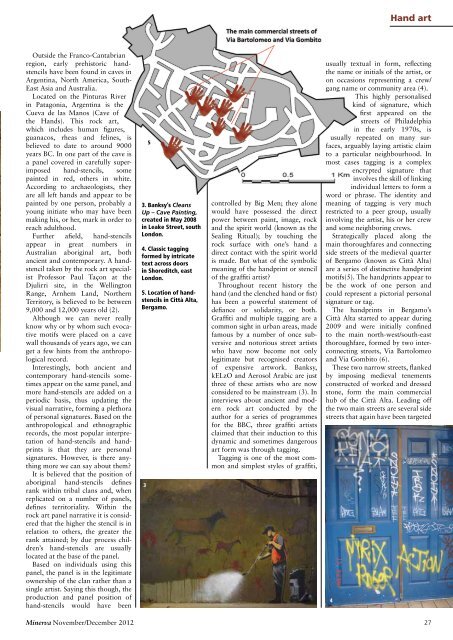Following Odysseus Not the end of the world Amarna city of light ...
Following Odysseus Not the end of the world Amarna city of light ...
Following Odysseus Not the end of the world Amarna city of light ...
- No tags were found...
Create successful ePaper yourself
Turn your PDF publications into a flip-book with our unique Google optimized e-Paper software.
Hand artOutside <strong>the</strong> Franco-Cantabrianregion, early prehistoric handstencilshave been found in caves inArgentina, North America, South-East Asia and Australia.Located on <strong>the</strong> Pinturas Riverin Patagonia, Argentina is <strong>the</strong>Cueva de las Manos (Cave <strong>of</strong><strong>the</strong> Hands). This rock art,which includes human figures,guanacos, rheas and felines, isbelieved to date to around 9000years BC. In one part <strong>of</strong> <strong>the</strong> cave isa panel covered in carefully superimposedhand-stencils, somepainted in red, o<strong>the</strong>rs in white.According to archaeologists, <strong>the</strong>yare all left hands and appear to bepainted by one person, probably ayoung initiate who may have beenmaking his, or her, mark in order toreach adulthood.Fur<strong>the</strong>r afield, hand-stencilsappear in great numbers inAustralian aboriginal art, bothancient and contemporary. A handstenciltaken by <strong>the</strong> rock art specialistPr<strong>of</strong>essor Paul Taçon at <strong>the</strong>Djulirri site, in <strong>the</strong> WellingtonRange, Arnhem Land, Nor<strong>the</strong>rnTerritory, is believed to be between9,000 and 12,000 years old (2).Although we can never reallyknow why or by whom such evocativemotifs were placed on a cavewall thousands <strong>of</strong> years ago, we canget a few hints from <strong>the</strong> anthropologicalrecord.Interestingly, both ancient andcontemporary hand-stencils sometimesappear on <strong>the</strong> same panel, andmore hand-stencils are added on aperiodic basis, thus updating <strong>the</strong>visual narrative, forming a plethora<strong>of</strong> personal signatures. Based on <strong>the</strong>anthropological and ethnographicrecords, <strong>the</strong> most popular interpretation<strong>of</strong> hand-stencils and handprintsis that <strong>the</strong>y are personalsignatures. However, is <strong>the</strong>re anythingmore we can say about <strong>the</strong>m?It is believed that <strong>the</strong> position <strong>of</strong>aboriginal hand-stencils definesrank within tribal clans and, whenreplicated on a number <strong>of</strong> panels,defines territoriality. Within <strong>the</strong>rock art panel narrative it is consideredthat <strong>the</strong> higher <strong>the</strong> stencil is inrelation to o<strong>the</strong>rs, <strong>the</strong> greater <strong>the</strong>rank attained; by due process children’shand-stencils are usuallylocated at <strong>the</strong> base <strong>of</strong> <strong>the</strong> panel.Based on individuals using thispanel, <strong>the</strong> panel is in <strong>the</strong> legitimateownership <strong>of</strong> <strong>the</strong> clan ra<strong>the</strong>r than asingle artist. Saying this though, <strong>the</strong>production and panel position <strong>of</strong>hand-stencils would have been53. Banksy’s CleansUp – Cave Painting,created in May 2008in Leake Street, southLondon.4. Classic taggingformed by intricatetext across doorsin Shoreditch, eastLondon.5. Location <strong>of</strong> handstencilsin Città Alta,Bergamo.3controlled by Big Men; <strong>the</strong>y alonewould have possessed <strong>the</strong> directpower between paint, image, rockand <strong>the</strong> spirit <strong>world</strong> (known as <strong>the</strong>Sealing Ritual); by touching <strong>the</strong>rock surface with one’s hand adirect contact with <strong>the</strong> spirit <strong>world</strong>is made. But what <strong>of</strong> <strong>the</strong> symbolicmeaning <strong>of</strong> <strong>the</strong> handprint or stencil<strong>of</strong> <strong>the</strong> graffiti artist?Throughout recent history <strong>the</strong>hand (and <strong>the</strong> clenched hand or fist)has been a powerful statement <strong>of</strong>defiance or solidarity, or both.Graffiti and multiple tagging are acommon sight in urban areas, madefamous by a number <strong>of</strong> once subversiveand notorious street artistswho have now become not onlylegitimate but recognised creators<strong>of</strong> expensive artwork. Banksy,kELzO and Aerosol Arabic are justthree <strong>of</strong> <strong>the</strong>se artists who are nowconsidered to be mainstream (3). Ininterviews about ancient and modernrock art conducted by <strong>the</strong>author for a series <strong>of</strong> programmesfor <strong>the</strong> BBC, three graffiti artistsclaimed that <strong>the</strong>ir induction to thisdynamic and sometimes dangerousart form was through tagging.Tagging is one <strong>of</strong> <strong>the</strong> most commonand simplest styles <strong>of</strong> graffiti,usually textual in form, reflecting<strong>the</strong> name or initials <strong>of</strong> <strong>the</strong> artist, oron occasions representing a crew/gang name or community area (4).This highly personalisedkind <strong>of</strong> signature, whichfirst appeared on <strong>the</strong>streets <strong>of</strong> Philadelphiain <strong>the</strong> early 1970s, isusually repeated on many surfaces,arguably laying artistic claimto a particular neighbourhood. Inmost cases tagging is a complexencrypted signature thatinvolves <strong>the</strong> skill <strong>of</strong> linkingindividual letters to form aword or phrase. The identity andmeaning <strong>of</strong> tagging is very muchrestricted to a peer group, usuallyinvolving <strong>the</strong> artist, his or her crewand some neighboring crews.Strategically placed along <strong>the</strong>main thoroughfares and connectingside streets <strong>of</strong> <strong>the</strong> medieval quarter<strong>of</strong> Bergamo (known as Città Alta)are a series <strong>of</strong> distinctive handprintmotifs(5). The handprints appear tobe <strong>the</strong> work <strong>of</strong> one person andcould represent a pictorial personalsignature or tag.The handprints in Bergamo’sCittà Alta started to appear during2009 and were initially confinedto <strong>the</strong> main north-west/south-eastthoroughfare, formed by two interconnectingstreets, Via Bartolomeoand Via Gombito (6).These two narrow streets, flankedby imposing medieval tenementsconstructed <strong>of</strong> worked and dressedstone, form <strong>the</strong> main commercialhub <strong>of</strong> <strong>the</strong> Città Alta. Leading <strong>of</strong>f<strong>the</strong> two main streets are several sidestreets that again have been targeted4Minerva November/December 2012 27
















